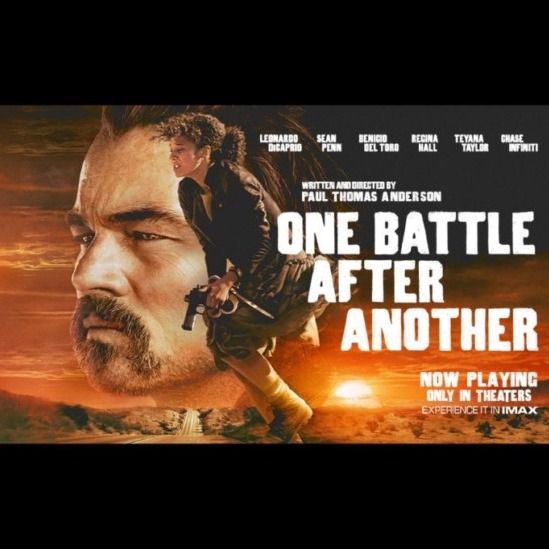
Review: America is ripe for resistance in One Battle After Another
Paul Thomas Anderson thrills with latest movie
Paul Thomas Anderson’s latest movie, One Battle After Another (2025), declares that the current American moment, in all its despair, is ripe for reinvention and resistance.
The film begins at a blistering pace during Barack Obama’s first term and follows the French 75 — a spirited militia — freeing detainees at the American and Mexican border. Led by Perfidia Beverly Hills (Teyana Taylor), the ragtag band of revolutionaries tears across America, bombing offices and robbing banks. Their crime spree attracts FBI agent Steven J. Lockjaw (Sean Penn), who enters into a perverted cat-and-mouse chase with Perfidia. Meanwhile, her relationship with demolition expert — and fellow 75 member — Ghetto Pat (Leonardo DiCaprio), results in a daughter neither of them seems equipped for — especially not Perfidia. Things quickly go south for the 75, and Pat is forced to flee with his daughter under the newly-assumed identities of Bob and Willa Ferguson. Without Perfidia, they travel into the woods of California.
Fast forward 16 years, and that revolutionary love-child is now a teenager (played by up-and-comer Chase Infiniti) who seems to be doing more of the parenting than Pat. DiCaprio, in The Big Lebowski-like swagger, is too preoccupied with smoking weed, vaping and drunk driving to parent his precocious daughter. Lockjaw’s bid to enter a white nationalist secret society sends him on a hunt for the Fergusons; Willa flees, Bob races after her, and a #girldad epic ensues. Whimsical side characters appear along the way, including a troupe of roof-hopping skaters, an all-Black nunnery in the Southern California hilltops and Benicio del Toro as a karate teacher at his most slyly charismatic since The Usual Suspects (1995).
The script loosely adapts Thomas Pynchon’s 1990 novel Vineland, Anderson’s second attempt at translating the mysterious author to the screen after Inherent Vice (2014). As Kathryn Schulz of the New Yorker said in her review of Pynchon’s latest novel, Shadow Ticket, present-day America is eerily similar to the weird, bureaucratic dystopias of the author’s work. The filming of One Battle After Another wrapped in 2024, before the inauguration and subsequent nightmare of Trump 2.0. Many hail the film’s timeliness, but one wonders if the dark reality of Trump’s second go — where billionaires run an elusive, memeified government agency, and the national guard assaults the country’s biggest cities — eclipses One Battle’s satire.
When my roommate and I left the theatre, we ascended Park Lane Mall’s frozen escalator, buzzing with excitement. Days later, when rehashing the movie’s politics, he questioned (perhaps because he’s American) whether the buffoonish portrayal of the French 75 undercut the movie as an inspiring call to arms. After texting my filmmaker aunt to see if she loved it as much as I did, she responded, “I HATED IT !!” followed by, “Any politics it might have had got lost in all the silliness and the comedy that didn’t make me laugh.”
Perhaps because I’m Canadian — with a false sense of distance from the issues plaguing our southern neighbour — I had license to appreciate it on a purely cinematic level.
To be sure, the movie lacks The Battle of Algiers (1966)-level gumption and jabs freely at the supposed do-gooder resistance. However, its real strength lies in its sheer aesthetic prowess (it is a technically masterful movie) and its nerve to talk about America today. While no other mainstream movie seems willing, One Battle After Another depicts a state of the union whose defining condition is its ever-deepening absurdity.






